|
|||
|
The marvelous wheel of Johann Bessler
The attempt of a recontruction |
|
 |
|
|
The beginning
Bessler often speaks of the "first mover", a main symbol of the traditional Metaphysik. It symbolizes the cause of all movement and as axle (world tree) is predominantly represented. This symbol emerges in all old traditions. The basic principle we find therefore very much-probably in the axle. But how an axle can be the propelling strength of a perpetum mobile? We find references to it completely at the beginning of its poem in the "Apologia": The avarice is a root evil, An anvil gets many blows. Blows - steel, vibration, a vibrating axle. A phenomenon, which are prevented in the modern mechanics at any price, because it releases forces, which the whole construction threatens to destroy. How now can a vibrating axle for an energy gain be used? In combination with standing (inverted) pendulums. They will become with vibrating axles accelerated, normal (hanging) pendulums braked. A descriptive application of this principle shows an old Chinese toy, the Hui-Machine. Now however this energy gain must be transferred somehow to the wheel. As is common knowledge, a wheel hardly can be moved by impacts. Therefore it needs a second conception, which makes this power transmission possible. We remember: "the avarice is a root evil", a reference that we must carry out first initial work, the operation of the stemmer (pounding work, point D with the woodcut completely above). Naturally Bessler considered itself, how he can optimize the performed work. A torque storage system is imposed. In addition it attached gear wheels, which are provided with a spiral spring in the inside at the periphery. These gear wheels lead an internal wheel, better said a flexible tire, according to the principle of a trolley. This tire is easily eccentric arranged, so that the carried inverted pendulum in the lower, possibly also in the upper quarter, get jammed, in the left and right quarter the pendulum can move freely. How he has managed this, we see later. Now if a soil compactor is raised, the inertia of the tire, plus the inertia of the inverted pendulum, causes a storing of the torque. |
|||||||||
| The construction For the structure of the construction we follow Besslers poem from its work "Apologia". We will see, how this poem contains the structural drawing for its perpetum mobile in refined way. |
|||||||||
| The avarice is a root evil Operation of the pounding work must be carried out for initial work. An anvil gets many blows The vibrating axle.  A driver drives. A runner runs. The seer sees. The buyer buys. The rain drips down. Snow falls; The shotgun shoots. The bow twangs; These four lines describe on the one hand the substance (form and movement) of the wheel, on the other hand the working forces. The substance is described by means of the first line. This line differs from the other three by the indefinite article. Driver: the turning part, exterior wheel and flexible tire. Runner: the inverted pendulum, resembles a run movement, since only in a certain section a contact exists. Seer: Swinging of the axle in the direction where no contact to the pendulum exists. The pendulum follows by the centrifugal energy of the axle in the back. Buyer: Swinging of the axle in the direction where contact to the pendulum exists. The axle pulls the pendulum inward and thereby is accelerated, a fair barter deal. Rain flows: the accelerated movement of the pendulum, the pulled pendulum resembles the adhesion (connection strength) of flowing water. Snow falls: no adhesion, free fall of the pendulum. Shotgun shoots: the striking of the pendulum in the torque storage system. Bow twangst: the pendulum leaves the torque memory accelerated, since the flexible tire widens briefly before somewhat and snaps back then again. This effect is released by the pounding work, said more exactly by the Stamp's knocking on the wooden box. The developing sound pressure squeezes the wheel together easily, which changes geometry of the suspension of the torque storage system. This mechanism forms the fundamental controlling of the whole operational sequence. How it functions in the detail, we see later. Now the description of the actual construction units of the machine follows, from the inside outward. It is remarkable, how the particular construction units fulfill always three completely different functions, as Bessler said: A thing consists from the three realms. |
|||||||||
| Here wanders a great fat herd of fat, lazy, plump horses The flail would rather be with the thresher than with the scholar The horses, a packing and working animal, are large bearings from brass. Brass is suitable for an application without lubrication, since it exhibits a tiny abrasion. They fulfill the following three functions:
|
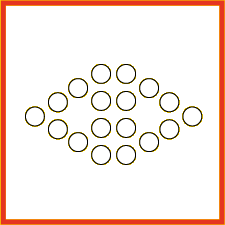 |
||||||||
 |
|||||||||
| In Besslers inventory such large brass balls was found actual: see Besslers inventory These brass bearings have different sizes. The two series in the middle part are somewhat smaller than the remaining. Thus the axle tilts on the left and on the right somewhat downward. 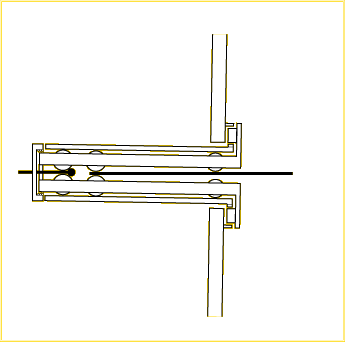 This arrangement produces a free space with the bearings lying inside, so that the axle is as unhindered as possible in its vibration. At the same time one of the balls strikes periodically to the axle to energize the vibration. The wheel is being carried all the time by one bearing alone, this by the majority in an easily eccentric support, forwards and back swinging. The whole wheel is thus even a pendulum (very small amplitude). It is this oscillation, which absorbs Bessler with its two outside pendulums.
Likewise under this arrangement a profile of the wheel results, that is downwards much thicker than upwards. Bessler expresses itself completely clearly in its "Triumphirat": ... the height/thickness of the profile however in 15. to 18. inch holds. Regards one the above woodcut (or copper pass) one sees like the wheel at the bottom is substantially broader than on the top. Thus a basis for the eccentric suspension of the torque storage system is given. 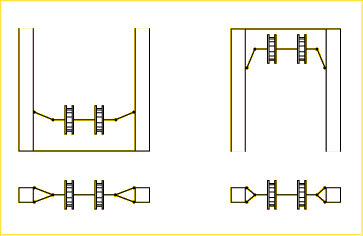 Bessler (Apologia): Frag' die, so in mein Werk getastet, Und dessen Welle angefastet; Alsbalde du versichert bist, Daß meine Welle nicht so ist, Sondern, sie hat vielmehr viel' Fächer; Ja, durch und durch verschiedne Löcher. |
|||||||||
| The children playing on the pillars With nothing but "Schniebe-käulgen"; Air jumper, feather fencer are Fast and slapping like the wind. The children are small wheels, which are swivelling stored attached to both pendulum ends. Into these wheels weights are applicable, which are held with a clamping spring something. At the same time blocking devices are present, which limit the range of rotation to 180°. As the pendulums are striking in the torque storage system, the weights snap due to their inertia upwards. Their three "realms" are:
|
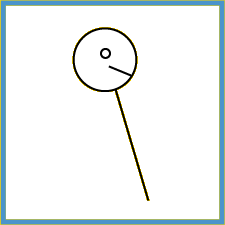 |
||||||||
| «Airjumper», after old-German encyclopedia, one who undertakes gimmick air jumps (salto). This is the upward throwing of the weights. Bessler writes in its "Apologia": They appear as pairs, so that, if the one takes an outer position, the other takes position near to the axle. Later, they change their positions, and they go on so all the time. "Feather fencer" is a medieval fencing guild, which trains with special training swords. The swords are in such a way designed, apart from a blunt point, that they simulate the impact point beyond the sword point, thus like an inverted pendulum. |
|||||||||
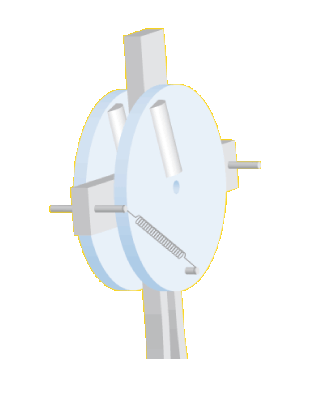 The double execution is necessary for the bi-directional mode. Because by the blocking device and clamping spring arrangement, the mechanism fulfills its obligation only in one direction. Hence that one pendulum is always over weighty, the other one is over weighty only with each second revolution. To both together applies: one revolution over-weightily, the next revolution weightily. So that with each revolution an effect of a over-weightily inverted pendulum is present, Bessler arranged two of such pendulums. Bessler (Apologia): Denn wenn ich mache hier bereits In ein Werk gleichsam nur ein Creuz, So wird man es ganz langsam sehen Kaum von sich selber herum drehen; Hingegen, wenn ich zugericht?t Viel Creuze, Züge, und Gewicht?, So kan das Werk viel schneller lauffen; Wirfft Wagners Rechnung übern Hauffen; Ja, die mir zu erkandte Schand? Wird weg von Mir auf Ihn gewandt. |
 |
||||||||
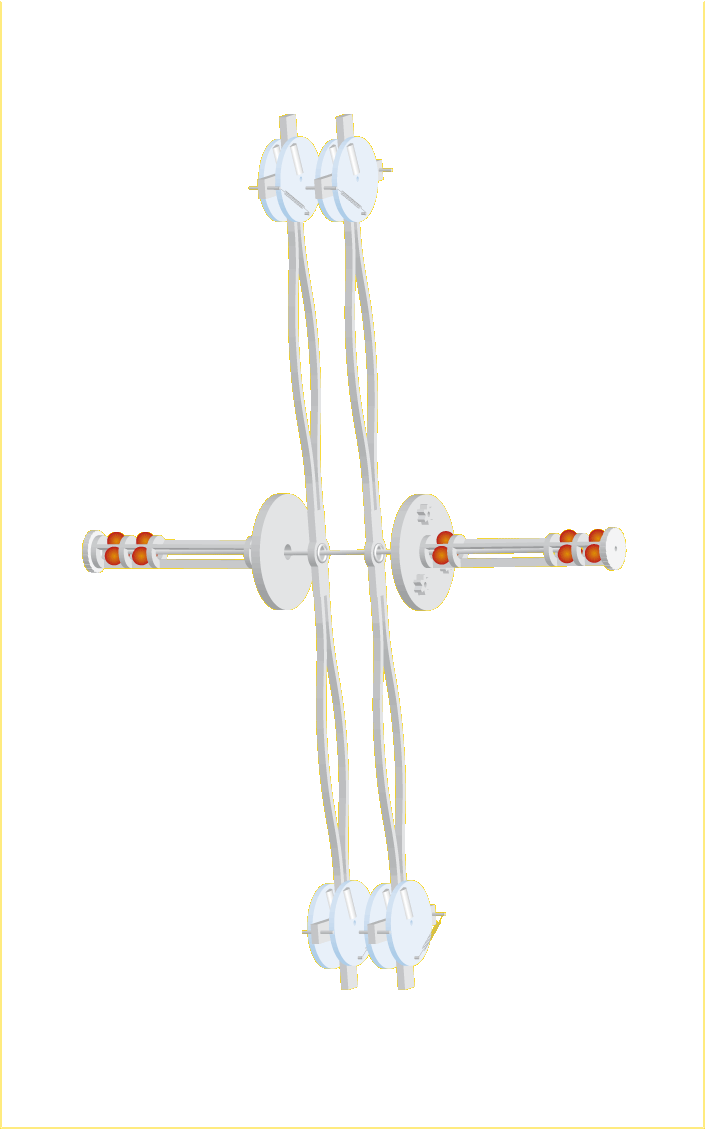 |
|||||||||
| The cunning cat slinks silently along, And snatches nice juicy mice. The cat, as already anticipated, is the torque storage system, inclusive exterior wheel. The creeping movement is the pre and back swinging of the flexible tire. The fat mice are naturally the falling down of the inverted pendulums. The torque is stored by the spiral springs in the internal guidance gear wheels. Their three "realms" are:
|
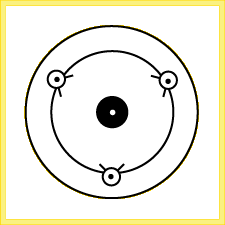 |
||||||||
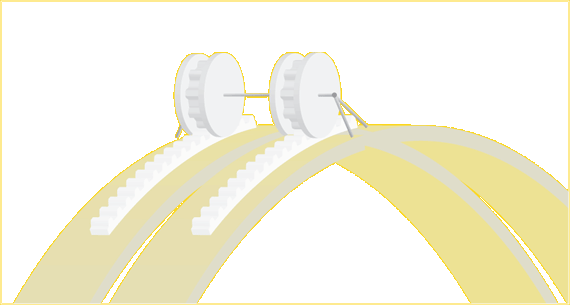 |
|||||||||
| The outside wheels have a gear wheel ring in the center interior. This propels the 3 gear wheels of the "herd". These again propel an outside gear rim on the centerline (dog). As one easily determines concerns it an oversized planetary gear here This is necessary, so that with the running of the wheel in both directions the ramming device can be operated. That is called thus, the part of the centerline, which lifts the stemmer, always turns into the same direction. This behavior can be realized by a planetary gear, depending upon which the bar (mounting plate of the planetray gears) is held or whether it is running. This behavior can be analyzed with the following Java applet (Simmulation planetary gear) : Simmulation planetary gear: Place for the engine the value on 850. For the one direction of rotation, set the engine to 0 -> the Genarator turns now with -2250. For the other direction of rotation, set the engine to 1250 -> the generator turns now with +2310. The small differences develop, since the applet does not operate steplessly. |
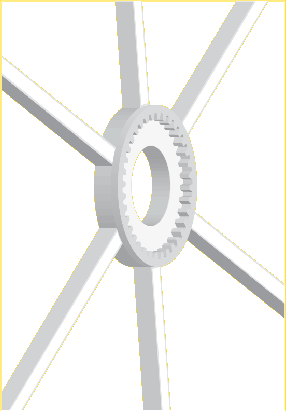 |
||||||||
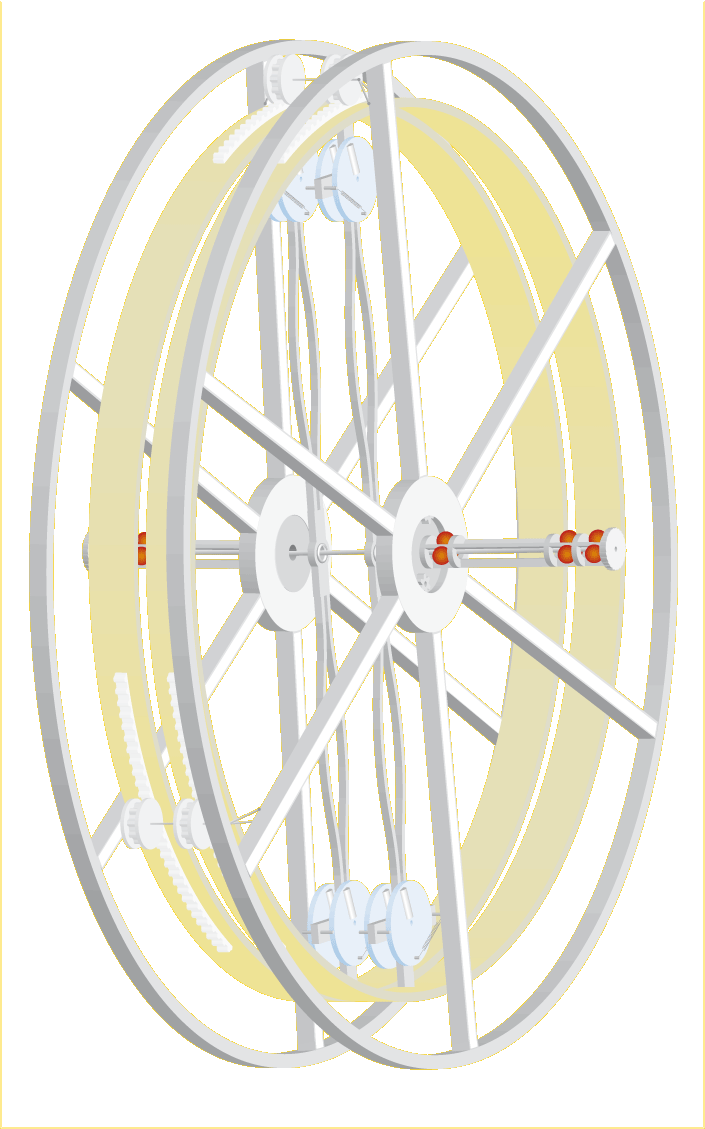 |
|||||||||
| The dog creeps out of his kennel, just as far as his chain will stretch. The beautiful treasures and machines He knows very friendly to serve; He waggles too with his tail, Creeps on his belly through the hoop; Therefore soon the droughty pastors Him pretty on the paws are knocking. The dog guards the outside regions. It forms the skin of the machine in a kind. It essentially consists of two thick-walled wooden hollow cylinders, which are, on the left and on the right, put over the large ball bearings (herd). It guards thus the herd. Its three "realms" are:
|
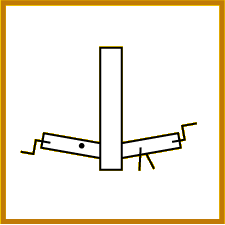 |
||||||||
 |
|||||||||
| The dog creeps out of his kennel, just as far as his chain will stretch. The two cranks on both sides of the centerline serve for trims of the torque storage system, i.e. optimize the power production of the inverted pendulums.
|
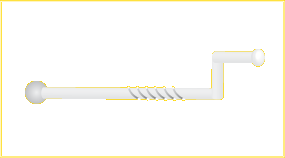 |
||||||||
| If one turns at the crank, then becomes, depending upon direction of rotation, the wheel strained (apart pulled) or relaxed. This affects the eccentricity of the torque storage system. The range, where the inverted pendulums have contact, becomes larger, the drop distance becomes smaller and in reverse. Naturally the wheel can become only so far strained, until the suspension of the torque storage system is stretched (nevertheless only so far the chain will stretch). Besides these cranks are suspended in two pan bearings, from which Bessler mentions that they are copped a bit. These pan bearings again are embodied into two rather narrow boards, which exhibit to the mounting plate above about the same distance as to the lower mounting plate. It seems to form also this again a swingable system. |
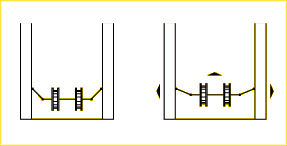 |
||||||||
| Most important function of this oscillationable support exists in the "timing" (synchronisation) of the free-falling inverted pendulums. Because every time one of the stemmer down-falls and impacts with loud bang on the wooden box, the sound pressure causes squeezes together the outer wheels, made possible by this oscillationable suspension. The flexible tire of the torque storage system lowers itself somewhat and hands thereby the pendulums to the free case over. |
|
||||||||
| The beautiful treasures and machines He knows very friendly to serve; The thick-walled hollow cylinder forms the main part of the dog. Into its thick skin still wood slats are screwed in (the paws, not drawn in), which serve the lifting device of the pounding work (machines). |
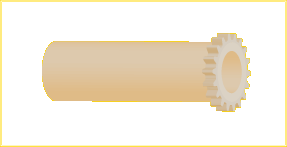 |
||||||||
|
|
|||||||||
|
|
|||||||||
| He waggles too with his tail, Creeps on his belly through the hoop; Therefore soon the droughty pastors Him pretty on the paws are knocking.; The cranks are firmly connected with the left and right cover plate. Crank and cover form then the locking of the bar of the planetary gear (for one direction of rotation, with the direction of rotation moving in opposite directions runs the bar with). Therefore interior a return barrier is appropriate, which takes up the end of the roller bearing mounting plate (herd). Naturally the crank must be connected with the outside pendulums for locking. Although Bessler mentioned that the wheel runs also without the outside pendulums, I assume that this applies only to one direction of rotation. The locking of the bar leads, as we with the different roller bearing positions saw, to an easy oscillating motion, (he waggles too with his tail). Creeps on his belly through the hoop: a reference to the buckling of the main axle by the differently large bearings. Therefore soon the droughty pastors Him pretty on the paws are knocking: Die The pastors are the long liftings device of the stampers, which resemble the reminding finger of a church dignitary. |
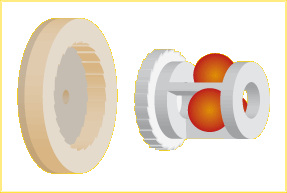 |
||||||||
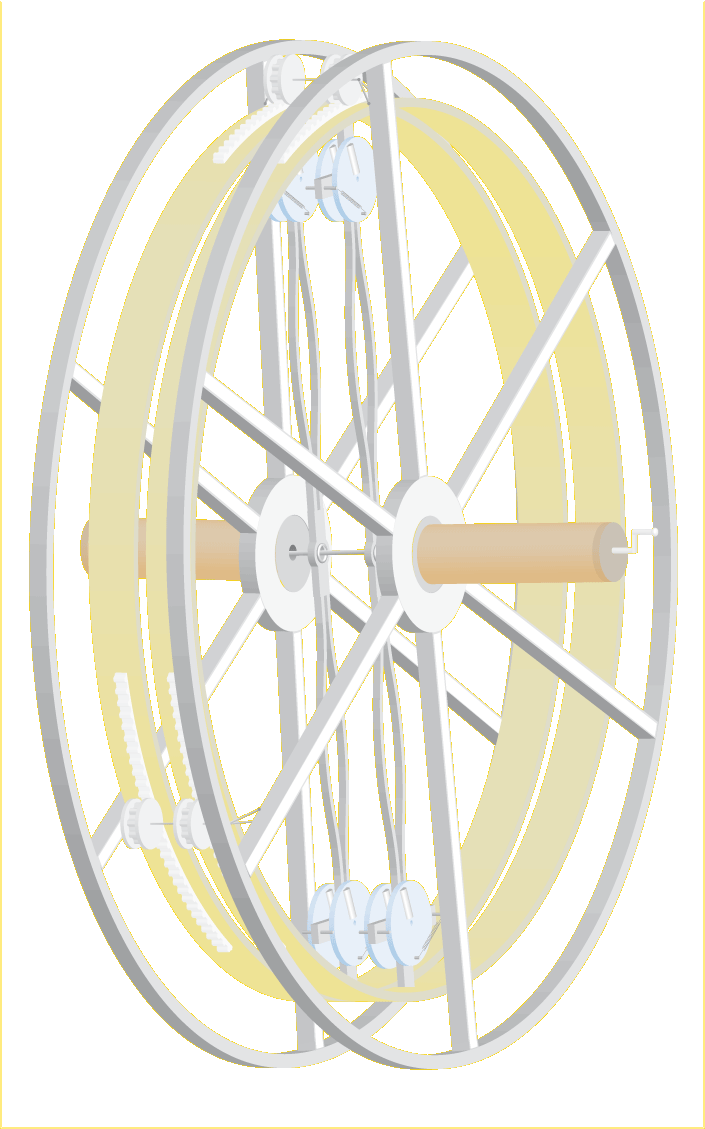 |
|||||||||
| The fundamental construction is hereby final. Which follows afterwards, are further references, which concern different aspects of the wheel. | |||||||||
| One sees a wheel, and also no wheel, because their is a rim and also no rim. It runs without inner and outer wheels, Cymbal weight, wind and mainspring. The rim is a tyre, which is fastened over spokes to the axle. With the Bessler wheel the spokes are the inverted pendulums, if they have contact with the torque storage system. Since this is in the running mode only periodically the case, the statement "because their is a rim and also no rim" makes sense. The second part of the section points out that no mechanical mechanism is present, which the propelling strength (the first mover) to the wheel transfers. Also this is here given, since the vibrating axle represents this propelling strength. The axle affects directly the inverted pendulums. |
|||||||||
| Here it is visible half, there it is visible full; It boasts like a peacock's tail.
|
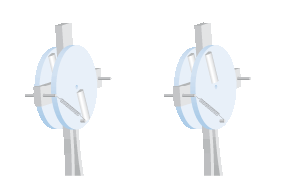 |
||||||||
| The movement in the side view would look about as follows: |
|
||||||||
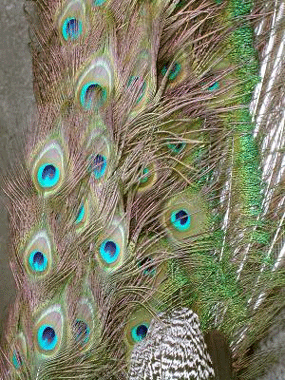 |
|||||||||
| It turns to the right and to the left One may it beckon only with fingers. The bi-directional design of the wheel (build at Weissenstein). The following is well-known: If one knocked against the wheel completely easily, it stopped again. If one knocked against it somewhat more strongly, then the wheel accelerated itself automatically, so that it, after approximately 2-3 revolutions, reached a stable, continuous rotation. Also this behavior is easy to explain. If one knocks against it too easily, then the torque storage system absorbs the rotation, the wheel oscillates easily back and forth. The impact must be so strong (or to be longer led) that the inverted pendulum leaves the contact zone and goes over to the free fall. Starting from this moment the wheel accelerates itself. |
|||||||||
| It spreads lengthens’ and crosswise’, Here it is fully, there it is empty’ The eccentric suspension of the torque storage system, released by the axle tilting in the center, causes a constant changing of the along and transverse axis of the wheel. For an observer this flowing change of the wheel dimension seems static, because down the cross section is at the broadest and in the center is largest always the diameter. Therefore the inverted pendulums within the upper and lower range from the torque storage system are clamped (fully) and within the left and right range they are able freely to turn (empty). |
|||||||||
| A thing consist’t of the three realms; You have touchable indications, Without’ sulfur, salt, mercurius Also a thing soon past by. Sulfur, salt, mercury (Mercurius) are three fundamental terms from the Alchemie. They designate the three basic tendencies of the subject, similarly to the three Gunas of the Hindus Sattvas (sulfur), Rajas (Mercurius), Tamas (salt). Sulfur means the active (ascending) tendency, salt the passive (descending) tendency, mercury the neutral (transferring) tendency. Transferred to the mechanics of the Bessler wheel they mean: Impulse, inertia and power transmission. The impulse takes over the herd (knocking the ball bearings to the axle), the inertia takes over the children (mass of the torque storage system) and the power transmission takes over the cat (torque storage system). |
|||||||||
| The qualities of the elements; Also each things must consists of. Saturnus, Mars, Jupiter finely To every war they are willingly. The role of the elements are: the herd (fire), children (water), cat (air) and the dog (earth). They are therefore in the appropriate colors dyed. |
|
||||||||
| The arrangement of the planets in the solar system can be interpreted as an inverted pendulum. The earth, which in the traditional conception of the world was not taken as planet, forms the axle (center) of the turning wheels (children). Therefore they are willing to each war, since they accelerate the pendulum. |
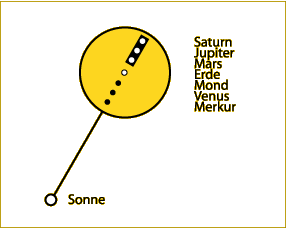 |
||||||||
| The thing also, (about which one feeds oneself) Moves through the bowel, the marrow and the legs; A crab creeps ahead and back And is healthy (well prepared.) Here Bessler takes up again the idea of the three realms. The admission of the food in the intestine forms the impulse, the marrow transfers the energy and supplies it to inertial (supporting) part, the legs. The crab, the flexible tire of the torque storage system, creeps forwards and back. Many were surprised, why Bessler speaks here of forwards and back, since generally admits is that the crab implements this movement laterally. Again its rafinesse shows up also here, since the movement actually sideways is, if one regards accompanying illustration. And it is healthy (well prepared) refers on the circumstance, that the construction of this element is substantial, since it serves for the transmission of the energy gain. Critical are here before all the length of the gear wheel ring (crab's pincer) and the dimensioning of the spiral springs of the little wheels, which run in this gear wheel ring. This determines the distance and time of the movement. |
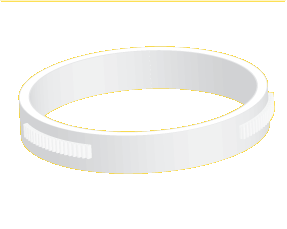 |
||||||||
| The rumbling ghosts freely walk Quite often through locked doors; Silently, silently, and let's stop, Stop, otherwise the enemy becomes only cute; The rumbling ghosts are the impact noises of the pounding work. They form, as we saw, the central control mechanism (synchronisation) of the wheel. Also its "Silently, silently, and let's stop" is a reference to the sound phenomenon. The locked doors refer to the difficulty to make the cover of the wheel (impregnated line) sufficient hermetic. If the cover would be only present, in order to hide the mechanism of the wheel, normal line (not impregnated) would have been sufficient. |
|||||||||